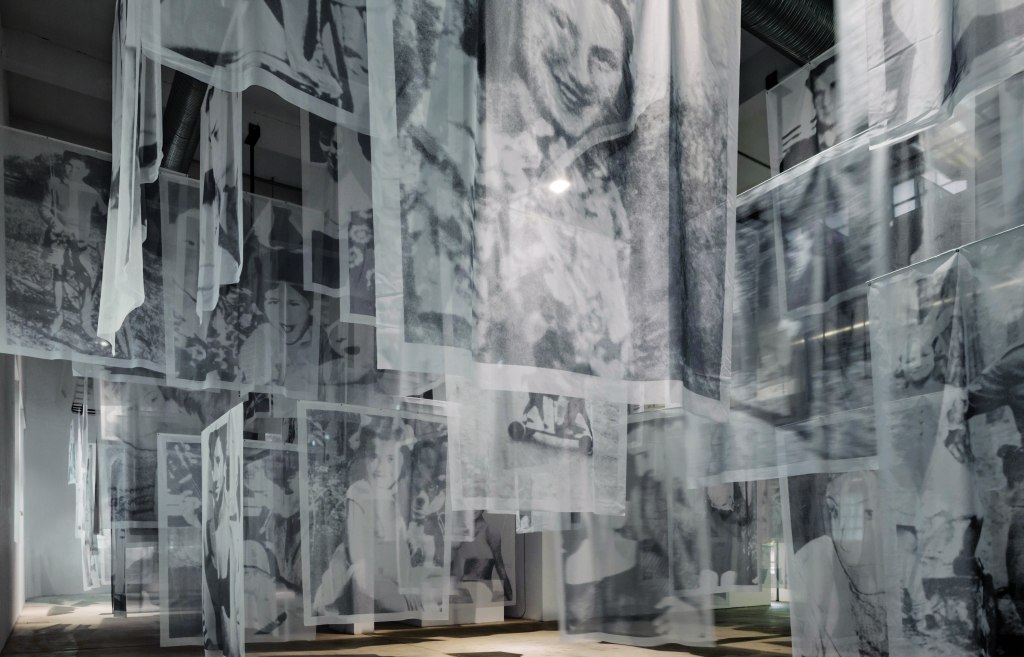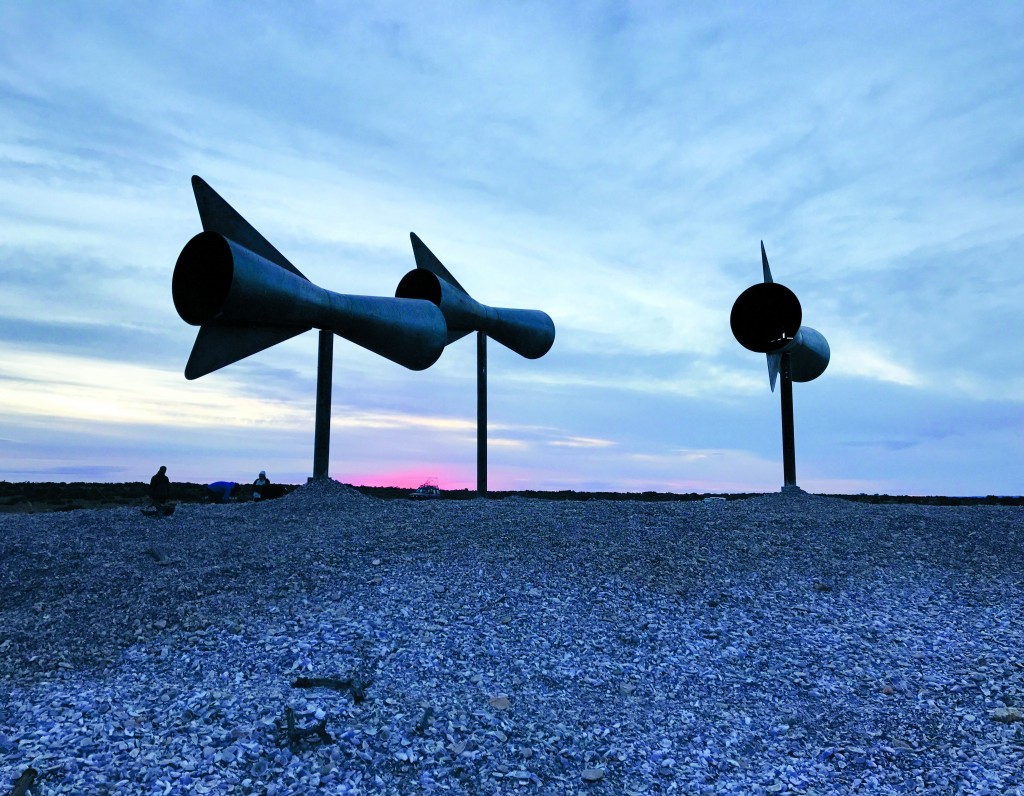In his seminal 1980 work “Camera Lucida,” the philosopher Roland Barthes wrote that “every photograph is a certificate of presence.” The French artist Christian Boltanski has spent the last 60 years probing the limits of such an idea, in a hybrid oeuvre that explores identity, memory, testimony, history and myth.
The Centre Pompidou’s new retrospective “Christian Boltanski: Life in the Making” (November 13-March 16) operates as an artwork in itself. 50 or so pieces – ranging from the artist’s early paintings to subsequent video works and installations – form a cohesive whole that somehow manages to sweep all of life’s magnitude into its midst. The exhibition has a theatrical quality to it; in a flurry of lights and curtains it stages a chronological exposition of life’s impermanence, bookended by two large neon signs hung at the entrance and exit: “Arrivée” (Arrival) and “Départ” (Departure). As life’s own journey finds its parallel in the duration of a visit, the show replicates the patterns and rhythms that govern our existence from birth to death – with recordings of heartbeats furnishing a fitting soundtrack.
While the show begins with Boltanski’s earliest work and ends with his most recent, a large part of the exhibition is taken up by the installations for which he is best known. These works are articulated in the artist’s deliberately sparse visual vocabulary: black-and-white photographs, lightbulbs, bare wires, metal boxes, somber-colored coats and simple sheets of cloth. As visitors move from room to room, they witness a proliferation of different combinations of these found objects – each combination extending a theme further, either complementing or complicating the work that precedes.
A theme that hangs heavy over the show is the Holocaust. Boltanski’s father, who was Jewish, spent the war hiding under the floorboards to escape persecution. He survived, but the stories of those that didn’t have haunted the artist’s work ever since. In the Pompidou’s show, the horrors of this period of European history resurface in the coffins of “The Tombs” (1996), the pervasive metal boxes which resemble urns or shrines for the dead, and the vast pile of jackets in “The Grand-Hornu Heap” (2015), which recall the harrowing inventories collected at concentration camps.
While oblique allusions abound, the installation “Chases Altar” (1988) is one of the rare works to address the subject directly. It is based on a class photograph taken in 1931 at a Jewish high school, Gymnasium Chases in Vienna; the school was shut down soon after, and the fate of the students remains unknown. Rather than presenting the photograph in its original form as a straightforward work of memorial, Boltanski re-photographed and enlarged the image so that each face is transformed beyond recognition. The resulting photos, which are closer to abstract monochromes or ghostly x-rays, have effaced all markers of individuality. What the work seems to display is less a person, less a Barthesian “certificate of presence,” but rather a representation of how time effaces and transfigures the individual. The work captures the way that history and storytelling transcend each individual life, blurring it into something altogether more collective, and perhaps, more enduring.
The relationship between individual and collective identity is a recurrent theme in the exhibition. Works such as “The Grand-Hornu’s Registers” (1997) and “Reserve: The Dead Swiss” (1991) are composed of towering stacks of metal boxes, each labelled with a name, and occasionally with a photograph. The sheer scale of the installations (made of hundreds, if not thousands of containers) makes contemplating each box impossible. Instead, the works enact the way each individual life is absorbed into a larger whole and erased in time’s unforgiving archives.
Even with works that appear, at first glance, to focus on a single identity, the viewer should be wary. The show’s sole autobiographical piece, “The Impossible Life of C.B” (2001), is comprised of cabinets containing archival fragments of the artist’s life – letters, postcards, photographs… But the narrator is an unreliable one, as Boltanski has frequently created works using faked photographs, or pictures of complete strangers passed off as his own family. Besides, as the artist has often pointed out in interviews, the line between true and false is quickly muddied; memory is a fickle thing; time transforms fiction into fact and fact into fiction.
With the historical reality of the Holocaust in the background, the themes that Boltanski considers come with high stakes attached. But even if his work subverts certain expectations around how the memory of the deceased should be honored, it is never irreverent or insensitive. And while it foregrounds how identity dissolves over time, subsumed instead in stories and knowledge transmitted through the generations, Boltanski’s art is not cynical or pessimistic.
In an interview printed in the exhibition handbook, the artist describes his own shift in focus from history towards mythology, and visitors see this materialize in Boltanski’s recent works exhibited at the end of the show. A projection of “Misterios” (2017) depicts the vast installation he created on the sea shore in Patagonia, in a bid to communicate with whales via the sound of the wind funneled through the trumpet-like structures. Boltanski reflects that while the work and the artist will disappear with time, what will remain is the myth: the man who tried to speak to the whales. The final works of the show echo a similar concern. The video projection “Animitas (Small Souls)” (2014) reveals a work he created in Chile to commemorate those killed under Pinochet’s political regime. The title evokes the shrines to the dead that line the roadside in the Atacama Desert, and in Boltanski’s tribute bells attached to rods sway precariously in the wind, their chimes carried by the breeze. This final image captures a great truth about art, and perhaps about life too: its quiet beauty may be fleeting, but it is no less powerful.

Christian Boltanski, Les Voiles, 2013 ©Fondazione Merz, Turin© Adagp, Paris, 2019 
Christian Boltanski, Réserve : Les Suisses morts, 1991 © IVAM, Institut Valencia d’Art Moderne © Adagp, Paris, 2019 
Christian Boltanski, Monument, 1987 © David Huguenin © Adagp, Paris, 2019 
Christian Boltanski, Misterios, 2017 © Christian Boltanski © Adagp, Paris, 2019 
Christian Boltanski, Animitas Chili, 2017 © DR © Adagp, Paris, 2019
Article published on Blouin Artinfo.
